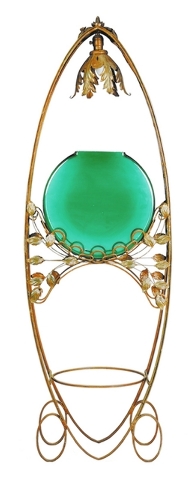Aquariums all the rage since 1800s
Keeping fish in an aquarium is said to be one of the top hobbies in the United States today. Some enthusiasts search for antique-looking aquariums that fit with room styles from the past.
It was not a hobby for an average householder until the 1830s, when the Wardian case was created as a simple container for live fish. By the opening of the Crystal Palace Exhibition of 1851 in London, aquariums were wonders suitable for a home, and two years later the London Zoo built a large aquarium.
The United States had enough people interested in raising fish indoors to form an “aquarist society” by 1843, and fish became part of a full-blown fad by the 1860s. Of course, that meant there were things to collect — an aquarium and equipment — like pumps and filters, rocks, small figures and scenery.
Decorators planned rooms with planters and aquariums in the prevailing styles of the time, from Victorian to Mission to Art Deco to modern. Old tanks made of wrought iron and glass, tanks bordered by heavy Mission-style oak planks, glass bowls held in wicker stands, and Art Deco designs using plastic instead of glass are sometimes found at antiques sales. And the small glass fishbowl for guppies or goldfish so popular in the 1950s still is available. Recently, a Deco aquarium made of wrought iron vines and leaves, and a clear, slightly green glass bowl was sold for $805. It had a light at the top and a holder for a large potted plant at the bottom. It’s probably the focal point of a room today.
Q: My great-aunt gave my mother a pretty porcelain bowl decorated with hand-painted acorns and leaves. It is marked “Elite L France” on the bottom. I’m 90 years old, so the bowl must be very old. Does it have any value?
A: The mark “Elite L [for Limoges] France” was used by Bawo &Dotter, an importer established in New York City in the mid-1860s. Bawo &Dotter founded a decorating studio in Fischern, Bohemia (presently Rybare, Czech Republic), in 1883 and was manufacturing porcelain in Limoges, France, by 1893. Bawo &Dotter’s “Elite” china was exhibited at the 1893 World’s Fair in Chicago. The company closed about 1914. Your bowl, probably made to hold nuts, is worth about $50 to $100.
Q: We own two paintings left to us by a friend who was a guard at the World War II POW camp set up at Westover Field in Chicopee, Mass. The paintings are signed “K. Skrobeck, 1945 POW.” We can’t find any information about the artist, but we would like to know if the paintings have any value.
A: Many World War II POWs tried painting while they were prisoners in the United States. It kept them busy and relieved boredom. Some even discovered they were talented. Biographical information about any one of these “artists” is hard to find. But POW paintings are part of the history of the war, and they can sell for hundreds of dollars if they’re in good condition, if the quality of the artwork is decent (no matter what the style) and if you can document their history.
Q: I have a number of chairs, in varying condition, that were once used in the board room of the Bank of Stockton in Stockton, Calif. A paper label on the bottom of the chairs says “Jacob &Josef Kohn, Wien.” Can you tell me something about this maker?
A: In 1849 Jacob Kohn and his son, Josef, of Vienna (Wien), Austria, founded a company that made wooden parts for buildings. The company began making furniture about 1867 and eventually established factories in several cities. The Kohns manufactured bentwood chairs similar to those made by Thonet. The Kohns’ company merged with Mundus in 1914 and the name became Kohn-Mundus, so your chairs were probably made before 1914. Kohn-Mundus merged with Thonet in 1922.
Q: We have a Westmoreland milk glass wedding bowl that was given to us on our wedding day in 1954. I have displayed it in a curio cabinet ever since. I also have a set of Milburn Rose sterling silver flatware made by Westmorland Sterling. Is there a connection between the items?
A: There is no connection between the company that made your milk glass wedding bowl and the company that made your sterling silver. Although the names of the companies are similar, they are spelled differently. Westmoreland Glass Co. was in business in Grapeville, Pa., from 1889 to 1984. Westmorland Sterling Co. was founded in 1940 to provide jobs for former aluminum workers, since most aluminum was needed for the war effort. The silver was made by Wallace Silversmiths, marketed by Wearever Aluminum, and sold by door-to-door salesmen. Milburn Rose is one of five patterns made by Westmorland Sterling Co. In 1966 Wallace took over the marketing the flatware and it became available in retail stores.
CURRENT PRICES
Current prices are recorded from antique shows, flea markets, sales and auctions throughout the United States. Prices vary in different locations because of local economic conditions:
Hull vase, wildflower pattern, dusty rose, handles, marked, 5 5/8 inches, $15.
Lindy Glider toy airplane, orange, blue paint, cast iron, Hubley, 6 inches, $120.
Nancy Lee doll, hard plastic, braided blond wig, blue dress, Arranbee, box, 17 inches, $170.
Stool, enameled steel, oak, adjustable, Toledo Metal Furniture Co., 1940s, 41 x 18 inches, $315.
Perthshire paperweight, blue and white overlay, central bouquet, clear ground, signed, 2¾ inches, $355.
Aluminum cocktail set, tray, shaker, six cups, plastic, chrome trim, wood handles, Farberware, 13-inch shaker, 8 pieces, $565.
Terry Kovel’s column is syndicated by King Features. Write to: Kovels, (Las Vegas Review-Journal), King Features Syndicate, 300 W. 57th St., New York, NY 10019.

















